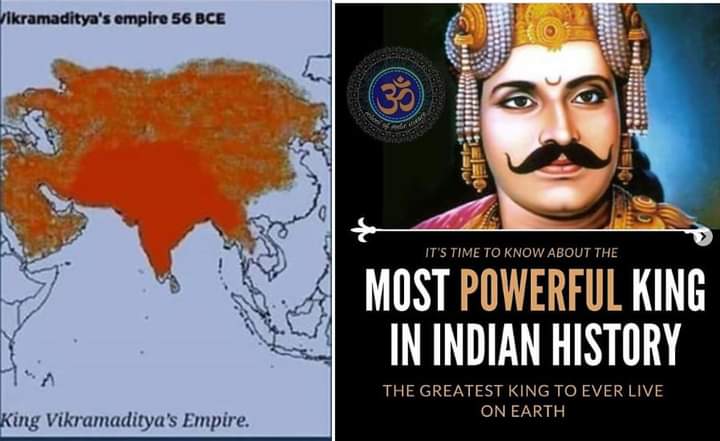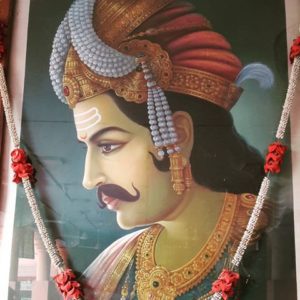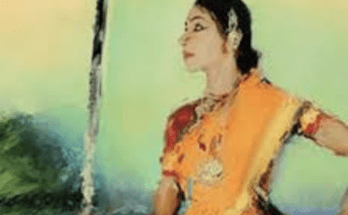In the annals of Indian history, few names shine as brightly as that of King Vikramaditya. This enigmatic monarch is remembered not only for his impressive rule but also for the enduring legacy he left behind. The Vikramaditya Empire, veiled in legend, embodies valor, wisdom, and benevolence. Vikramaditya’s reign marked a pivotal period in Indian history, and his contributions continue to inspire admiration and intrigue to this day. King Vikramaditya, revered for exemplifying kingly virtues continues to enchant generations with stories of his remarkable reign
Vikramaditya Empire: Unveiling the Storied Legacy
Emperor Vikramaditya of Ujjain the most powerful and just king in Indian History, made Bharat(India) a gold rich country to the extent that India used to be referred as (सोने की चिड़िया) Golden bird. It he who brought this supreme glory to India in Kaliyuga.
Today our mainstream history books do not refer his rule and consequently most of the people do not know about great Emperor world has ever known- King Vikramaditya. This is a great misfortune. Our land has produced great Heroes in every era, but we do not know our real history and we do not make even efforts to know more.
If we honestly consider the greatest king on planet Earth in last few millenniums was certainly Chakravarti Samrat Emperor Vikramaditya. He was an Indian King who used to rule 3/4th of the known world then.

Coin of King Vikramaditya
The Golden Age of Vikramaditya’s Reign
Most powerful King in History
The great king Vikramaditya, is known as most powerful and just King ever existed in last couple of millenniums. Considering his conquests and ruled territory he can easily be counted among the greatest kings of all time across globe.
Vikramaditya’s reign marked a golden age in Indian history. His rule was characterized by stability, prosperity, and cultural flourishing. Under his leadership, saw significant expansion and territorial conquests, establishing itself as one of the most influential empires of its time. The king’s administrative prowess and diplomacy allowed him to maintain peace and stability across a vast and diverse realm.
Vikramaditya’s contributions extended beyond the realm of politics and power. He was a patron of arts and culture, promoting learning and scholarship. His court was a haven for scholars, poets, and artists. It was during this time that some of the most iconic literary and artistic works of ancient India were produced, with figures like Kalidasa and Varahamihira enjoying royal patronage.
In fact, Vikramaditya started the title of ‘Chakravarti’ Emperor by the kings in India. Chakravarti Samrat means a king who rules in all four directions and doesn’t have any enemies left to challenge him at the time of obtaining the title of Chakravarti.
Vikramaditya History
Early Life and Ascension
According to the Pratisarga Parvan of Bhavisya Purana, he was the second son of Ujjain’s King Gandharvasena of Paramara dynasty. Vikramaditya was born on 102 BC and died on 15 AD. Bhartrhari (भर्तृहरि) was the elder son of King Gandharva-Sena. Vikramāditya was born in the Paramara dynasty to Gandharvasena (Father) and Viramati (Mother) as per Suta.
Legend behind Vikramaditya’s birth
According to Bhavishya Purana Vikramaditya was born in 101 BC. It is said that he was born with blessings of Lord Shiva and was an incarnation one Guhyakas Ganas based in Kailasa. Vikramaditya became Shaiva after doing 20 types of Karma (Kriya) yoga. He was born by orders of Lord Shiva to destroy Shakas and for growth of Arya-dharma after the year 3000 of Kaliyuga.
Vikramaditya was born to then King of Ujjain city, Gandharva Sena. King Gandharva Sena named his child Vikramaditya (some say Vikramark).
Both Vikramaditya and Vikramark have same meaning “Sun of Valour”.
As ‘Vikram=Valour’ and ‘Aditya or Ark=Sun’.
Even as an infant Vikram was very sharp and was endeared child of his royal parents. Although Vikramaditya took inspiration from ancient Hindu scriptures and left palace at an early age of five years to undertake penance in order to become great and earn some spiritual prowess and divine blessings. He spent twelve years in austerities, after having achieved some spiritual eminence and prowess he returned to his capital city Ujjain.
Coronation
Raja Vikram’s coronation took place on the day of Diwali festival in 57 BC at the age of 43 Years. King Vikramaditya made Ujjain (Ambavati) his capital. He had repulsed the forces not only from the borders of India but also from all over Asia.

King Vikramaditya Statue
Vikramaditya’s Epoch – 1st Century BCE
Vikramaditya’s empire reached as far as Arabia and Turkey in west (legends say he defeated even Romans) to as far as Indonesia in far East. In south his empire reached till Setusamduram-Ramsetu and in North he is said to ruled most of Tibet.

Vikramaditya Empire Spanned across Continents
King Vikramaditya’s empire included many parts of Modern-day China, Entire Middle East and Many Parts of Southeast Asia. Vikramaditya’s empire stretched from present-day India to Some of North Africa and Rome. · Not only did Emperor Vikramaditya trample the Arabs and Turks, but he also defeated Rome’s King Julius Caesar in battle.
Core Empire in Indian subcontinent
After the death of King Vikramaditya his kingdom gradually splitted into 18 parts. List of those regions is given below. In India, Chakravarti Samrat Vikramaditya’s empire empire stretched from west boundary was at the end of Sindhu River, in south the boundary was Setubandha-Ramsetu (Sea bridge by Shri Rama at Rameshwara), in north the boundary was upto Badristhana and upto Kapilantaka in east. This effectively covers all of India though his kingdom stretched far beyond till Arabia and Turly in west to Indonesia in East and till most of Tibet in North.
Vikramaditya’s capital was in Ujjain, present-day Madhya Pradesh, India. Ujjain thrived as a center of culture, art, and intellectual pursuit during his enlightened reign, drawing scholars, artists, and philosophers to his court.
Within his core Indian territory, 18 kingdoms arose post his demise. These were as follows:
- Indraprastha
- Panchala
- Kurukshetra
- Kapila
- Antarvedi
- Braja
- Ajmer
- Marudhanva
- Gurjara
- Maharashtra
- Dravida
- Kalinga
- Avanti
- Udupa
- Vanga (Bengal)
- Gauda (East Bengal, Asam)
- Magadha (Bihar, Chhotanagpur)
- Koshala
Emperor Vikramaditya Empire Map

Emperor Vikramaditya’s empire map is depicted in varying degrees according to various sources. However as per commonly depicted places conquered and controlled by him included areas from Arabia , a part of North Egypt, Turkey, then Persia, Afgasnisthan, Tibet, southern China and to some of southeast Asia as well.
The Warrior King
Vikramaditya was not only a wise ruler but also a formidable warrior. Accounts of his military conquests and strategic brilliance paint a picture of a fearless and visionary leader who expanded the boundaries of his empire while promoting peace and prosperity.
Vikramaditya’s Army size-An account by Kalidasa
Sanskrit writer Kalidasa says that King Vikramaditya army continuously spread over 18 yojanas (small jyotisha yojanas, 1 small jyotisha yojana is around 5 miles) and consisted of the following.
- There were 3 crores of soldiers.
- Ten crores of various vehicles.
- 24,300 elephants.
- 4,00,000 (Four lakhs) of ships
Why is King Vikramaditya famous?
Vikramaditya was a king who was the reformer of Vedic Bharat Varsh and who spread the vedic knowledge all over the world. During his time India was the wealthiest country in the world. He almost ruled whole Asia. His enemy was ‘Shaka’, an Iranian king, but shakas failed to defeat king Vikramaditya till last. ‘’There was no emperor who could be compared to Vikrama in those days”.
The Vikram Samvat Calendar
King Vikramaditya left a lasting legacy with the Vikram Samvat calendar, which marks the beginning of the Hindu calendar. Commencing from the year of his coronation, it symbolizes an era of prosperity and order within his empire, and is still in use today. However other historian says that he conquered Shakas and founded the world’s first calendar Vikram Samvat.
Indian calendar system still continues in his name and is known as Vikrami Samvat. In Vikram samvat system months and even years have specific names. The year 2023 has mostly passed in Vikrami samvat 2080 as Vikrami Samvat starts from bright fortnight of Chaitra month, which usually falls in March-April.
Vikram Samvat also known as the Vikrami calendar is the historical Hindu calendar in the Indian subcontinent. It is the official calendar of country of Nepal. Vikarm Samvat is at least 57 years older than the Gregorian calendar.
Legends of Justice and Wisdom
Vikramaditya’s legacy is best exemplified in the timeless tales of “Vikram and Betaal.” These stories depict his wisdom and unwavering commitment to righteousness. They are an integral part of the folklore within the India.

Navratnas – 9 Gems of Emperor Vikramaditya
Kalidasa mentions the nine Gems of scholars adorning the court of Vikramaditya. These were:
- Dhanvantari
- Kshapanak
- Amara Simha
- Shanku
- Vetala Bhatta
- Ghata kharpara
- Kalidasa
- Varahamihira &
- Vararuchi
King Vikramaditya endowed 10 million gold coin only on Sri Krishna Mishra, an astrology in his court for 70 years. Now imagine his wealth.
Another project undertaken by Vikramaditya was the royal road, the world’s longest, extending 1,700 miles. It is obvious that a smooth and fast commutation line was necessary to maintain connectivity and communication for such a large empire. Due to an extensive network of relays, postmen could travel the road in six to nine days, whereas normal travel time was three months. The motto of the Vedic postal service became memorable: stopped by neither snow, rain, heat or gloom of night. The US postal service also adopted this motto and the famous Pony Express mail delivery resembled the original Vedic design.
Ayodhya re-discovered
A local legend in Ayodhya states that the city was re-discovered by Vikramaditya, after having been lost for centuries. Vikramaditya started searching for Ayodhya, and met Prayaga, the king of tirthas (Prayaga personified). Guided by Prayaga, Vikramaditya marked the place, but subsequently forgot its location. A yogi told him that he should let loose a cow and a calf: Ayodhya would be at the place where milk starts flowing from the cow’s udders. Using this advice, Vikramaditya managed to re-identify the site of ancient Ayodhya.
Vikramaditya’s Enduring Legacy
As a prominent historical figure , Vikramaditya symbolizes the essence of an enlightened monarch. His tales have become an integral part of India’s rich heritage, imparting moral virtues, strategic acumen, and the unwavering pursuit of righteousness, leaving an indelible mark on the history of India.
The allure of King Vikramaditya’s persona lies not only in the grandeur of his reign but also in the timeless wisdom and values he embodies. His stories continue to inspire, making him an immortal figure in the narrative of Indian history.

King Vikramaditya FAQs
Q1. What was King Vikramaditya’s Religion?
A. Vikramaditya Religion: King Vikramaditya was a follower of Sanatan Dharm, which is popularly known as Hinduism today
Q2. What is the real name of Vikramaditya?
A. His real name was Vikramaditya only. It was not a title. Some people confuse him with King Chandragupt who took the title of Vikramaditya. But our hero King was named Vikramaditya (Some say Vikramark) only. Both Vikramaditya and Vikramark have same meaning “Sun of Valour”. As ‘Vikram=Valour’ and ‘Aditya or Ark=Sun’.
Q3. Who was the father of Vikramaditya?
A. Vikramaditya father’s name was King Gandharva Sena.
Q4. How Did King Vikramaditya live?
A. King Vikramaditya lived for 117 years (102 BC – 15 AD).
Q5. How long is Vikramaditya ruled?
A. King Vikramaditya ruled from 57 BC to 15 AD till his death. He was coronated around age 43 and then ruled till his last days in 15AD.
Q6. How long did Vikramaditya’s descendants’ rule?
A. Vikramaditya’s family had ruled from 57 BC to 1200 AD (when the rule of Prithviraj Chauhan and Bhoja of Malava began).
References:
Dibhu.com is committed for quality content on Hinduism and Divya Bhumi Bharat. If you like our efforts please continue visiting and supporting us more often.😀
Tip us if you find our content helpful,
Companies, individuals, and direct publishers can place their ads here at reasonable rates for months, quarters, or years.contact-bizpalventures@gmail.com






Vikramaditya was very just and powerful king. Legend of king Solomon has been picked from King Vikramaditya’s story only.